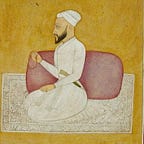Yes. Some of them anyway. I have a few dozen Indian Muslim genetic samples in Harappa format, so figured I’d compare them against their Hindu counterparts to see how they differ.
Note that this analysis will not tell us how much Middle Eastern ancestry Indian Muslims have, just if they have a significant amount relative to Hindus. This is accomplished by simply creating a Middle-Eastern and Central Asian ancestry category (ME-CA) composed of those Harappa components maximized in non-Indian Middle-Eastern and Central Asian populations, and seeing how it varies across different groups. Four regions of India; Uttar Pradesh (UP), Gujarat, Bengal, and Telangana/Hyderabad will be examined.
UP
Two UP Muslim clusters, A and B, have outlier ME-CA admixture proportions relative to what is found in UP Hindus. Cluster A looks to be the result of Brahmin (and likely Kshatriya) elites who intermarried with Turco-Persian conquerors during the medieval Muslim period. Cluster B is similar, though likely having a merchant-like Bania base, as opposed to the Upper-Caste admixture seen in Cluster A. Cluster C looks fairly Indian.
Gujarat
I only have one cluster of Gujarati Muslim samples, and they definitely have outlier ME-CA levels. They seem to be built from a Gujarati merchant Baniya base, which makes sense as Gujarat was historically a hub for Middle-Eastern traders.
Telangana
The Hyderabadi Muslim cluster looks like significant ME-CA admixture on top of a Telgu Brahmin base. This may not be the exact structure, given that many Hyderabadi Muslims were basically UP Muslims who later settled in South India and then proceeded to mix with local elites.
Bengal
Ideally I’d have Bengali Muslim samples from West Bengal to compare with their Hindu counterparts, but all I’ve come across are Bangladeshi Muslims, so I used those. Bangladeshi’s are somewhat off cline from most South Asians (including many Hindu Bengalis) due to their admixture from Southeast Asia, and predictably, they do not resemble Upper-Caste Bengalis. There may be signs of ME-CA admixture however, as Bangladeshi’s actually have a bit more Middle-Eastern ancestry than mid-caste Bengali Baniyas, which I would not expect given their otherwise eastern-shift.
In Closing
Some Indian Muslims undoubtedly have Middle Eastern and Central Asian admixture, likely from the Islamic period. Note however that most of these samples are drawn from individuals who claim Ashraf status, which could be skewing the results. For those not aware, Ashraf’s are the purported descendants of the Turco-Persian conquerors who founded Muslim rule in India, and likely do not comprise more than 20% of the general Indian Muslim population. That being said, there were Ashraf samples that registered no significant ME-CA admixture, and non-Ashraf samples that registered quite a bit.
I’m working on a separate piece that will analyze whether various Pakistani groups (particularly Punjabis, Sindhis, and Kashmiris), have Middle Eastern ancestry. I have a lot more samples for these Indus Valley populations, so hopefully will have some solid insights to share.
Notes:
- ME-CA is calculated by adding together the Caucasian, SW Asian, African, Mediterranean, Siberian, NE Asian, American, and Beringian components of Harappa, except in the case of Bengalis, where only the first four components are used, to avoid overlap with non-ME-CA Tibeto-Burman populations.
